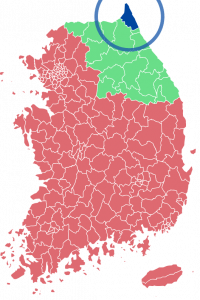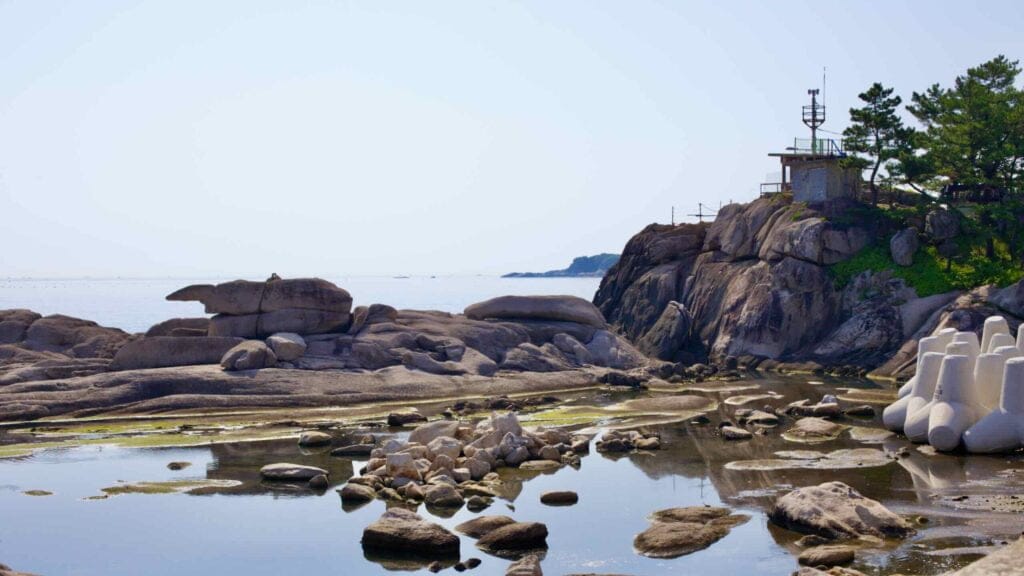
Goseong County
Goseong County (고성군; map) lies at the northeastern tip of South Korea, bordering North Korea across the Demilitarized Zone (DMZ). It combines mountainous landscapes from the Taebaek Mountain Range with extensive coastlines along the East Sea. Ranking 211 out of Korea’s 232 in population, it is also one of the nation’s most rural municipalities.
The region’s history dates back to the Kingdoms of Goguryeo (37 BCE ~ 668 CE) and Silla (57 BCE ~ 935 CE). But Goseong’s current location on the North Korean border shaped its identity today. The economy, once more focused on agriculture and fishing, now also incorporated tourism, capitalizing on the DMZ and location along the East Sea.
Goseong County’s key attractions include Seoraksan National Park, which also dips into Sokcho City, Songji Lake, Hwajinpo Beach, and the Unification Observatory. These sites offer insights into Korea’s natural beauty and historical narrative. The county’s dedication to preserving its environment and heritage makes it a destination for those seeking serenity, history, and natural wonders.
Coastal Goseong
A significant portion of Goseong’s population lives along this coastline, benefitting from the area’s rich fishing waters and beaches.
Goseong Ports
The ports in Goseong County are essential for the local economy, supporting fishing, trade, and tourism.
- Geojin Port (거진항; map): This port has witnessed significant growth from a small fishing village to a bustling maritime hub. At its peak during the 1970s, thanks to demand for squid, the population surged. Today, Geojin Port is known for its diverse catches, including pollock, octopus, and flounder. The port’s designation as a national port underlines its importance to the region.
- Gajin Port (가진항; map): Gajin Port is a picturesque and tranquil harbor that has served the fishing community for over a century. Known historically as Deokpo, the local seafood trade thrives on its seafood catches and scallop farming. The port’s facilities cater to small fishing vessels, with a market that attracts visitors looking for fresh seafood.
Food
Goseong County’s cuisine reflects its geographical diversity, combining flavors from the mountains and the sea. Here are some specialties from the region:
- Buckwheat Noodles with Radish Kimchi Broth (고성막국수; Goseong Makguksu): A refreshing dish, featuring buckwheat noodles in a cold, spicy radish water kimchi (동치미) broth. Served with ice and topped with slices of radish and boiled pork. A summer favorite for its cool and tangy flavors.
- Pollock Soup (명태맑은탕; Myeongtae Malgeuntang): This simple yet flavorful soup is made with pollock, a fish abundant in Goseong’s waters. Seasoned with garlic and salt, it offers a comforting broth rich in protein and low in fat.
- Raw Fish Soup (자연산 물회; Jayeonsan Mulhoe): This spicy and tangy soup combines freshly caught flounder, squid, and sea cucumber with an assortment of fresh vegetables, dressed in a vibrant red chili pepper sauce.
- Spicy Fish Stew (도치두루치기; Dochi Duruchigi): A heartwarming stew made with ripe kimchi and dochi (a local fish), known for its rich, spicy flavor. It’s a popular dish among locals and visitors alike, especially during the cold months.
- Pollack Fish Egg Stew (도루묵찌개; Doroumuk Jjigae): A delicacy filled with pollack fish eggs. This stew is a winter treat, celebrated for its chewy texture and the clean pollack taste.
- Mudfish Soup (추어탕; Chueotang): Sourcing mudfish from Goseong’s waters, this soup is a traditional Korean remedy for revitalizing energy. It’s packed with vitamin A and known for its health benefits.
- Blanched Octopus (문어숙회; Muneo Sukhoe): Featuring octopus caught off the northern shores of Goseong. This dish is served slightly blanched, with a chewy texture. Dipped in spicy sauce, it offers a burst of freshness.
- Yellowtail Sashimi (방어회; Bang-eohoe): Goseong is a prime location for yellowtail fishing. This dish showcases the rich, fatty texture of winter-caught yellowtail, known for its health benefits, including vitamin D.
- Sea Urchin (성게알 덮밥; Seonggeal Deopbap): A delicacy harvested from the waters between Cho and Geumgu Islands, sea urchins are rich in protein and known as the “hormone of the sea” for its health benefits. It’s served in various forms, including sashimi, rice bowls, or bibimbap.
Goseong Festivals
Goseong County offers a blend of festivals that showcase its maritime and agricultural heritage. Here are the notable examples:
- Pollock Festival (명태축제): Celebrated annually in October at Geojin Harbor, this festival honors pollock, a fish central to Goseong’s economy and culture. It features a variety of events, including a pollock cooking contest, cultural experiences, and performances aimed at wishing for a bountiful catch and safe fishing operations. The festival draws visitors with its unique blend of traditional fishing culture and local cuisine.
- Giant Octopus Festival (대문어축제): Taking place every May at Daejin Harbor, this festival celebrates the giant octopus, a key local species. It features activities like octopus catching and tasting events. The festival highlights sustainable fishing practices and the East Sea’s bounty.
- Wanggok Village Folk Experience Festival (왕곡마을 민속체험축제): From July to October, this festival invites visitors to step back in time in the ancient Wanggok Village. With activities like traditional grain milling, indigo dyeing, and mudfish catching, the festival glimpses into the rural life of Korea’s past.
The Eight Views of Goseong (속초8경) highlight Goseong County’s natural and historical richness. These iconic spots, ranging from ancient temples to calm lakes and scenic pavilions, offer a deep dive into the area’s diverse beauty.
- Geonbongsa Temple (건봉사; map): A temple of great historical importance, Geonbongsa was once the heart of a network of nine temples, including Sinheungsa and Baekdamsa in Seoraksan National Park. Founded during the reign of Silla’s King Beopheung, it reaches deep into Korea’s history with its architecture and spiritual practices.
- Cheonhak Pavilion (천학정; map; Cheonhakjeong): Constructed in 1931 by local leaders, this single-story pavilion sits on a cliff with interesting rock formations overlooking the East Sea. Surrounded by centuries-old pine trees, Cheonhak Pavilion is renowned as a sunrise spot, offering expansive views.
- Hwajinpo Lake (화진포; map): This coastal lagoon is the largest natural lake along Korea’s east coast. Its 16-kilometer circumference is surrounded by dense pine forests, historical retreats, including Kim Il-sung’s Villa, Rhee Syngman’s Villa, and Hwajinpo Ecological Museum.
- Cheonggan Pavilion (청간정; map; Cheongganjeong): This historic pavilion perches on top of a rocky cliff overlooking the East Sea. First built in 1560, the pavilion features a plaque written by President Syngman Rhee in 1953. Gangwon Province designated the pavilion a cultural treasure, and it is included in the ancient “Eight Scenic Spots in Gwandong (coastal Gangwon State).”
- Ulsan Rock (울산바위; map; Ulsanbawi): Dominating the landscape on the border of Sokcho City and Goseong County, Ulsan Rock is the most celebrated peak on Seorak Mountain. Towering 900 meters above sea, this natural formation is composed of six massive, bare-faced rocks that form a 4-kilometer long circumference.
- Unification Observatory (통일전망대; map): Pressed up against the DMZ, the Unification Observatory gives visitors a high-angle view into North Korea, where they can view the revered Geumgang Mountain. The observatory also offers a museum and exhibits telling the history of the Korean War and the division of the Korean peninsula.
- Songji Lake (송지호; map; Songjiho): Surrounded by lush pine forests, Songji Lake boasts clear waters and a serene atmosphere. The nearby Jukdo Island enhances the beauty of the lake, making it a perfect spot to observe nature.
- Masan Peak Snowscape (마산봉설경; map): Near Jinbur Pass on the Baekdudaegan Ridge, Masan Peak offers stunning views of the East Sea and its snowy environs during winter. The contrast between the azure sea and the white landscape provides a unique and natural spectacle.
Inland Goseong
Like other coastal municipalities in Gangwon State, the Taebaek Mountain Range fills Goseong County’s interior. It offers a sanctuary for lush forests, mighty peaks, and those drawn to the quietude of nature.
Key highlights include the revered Geonbongsa Temple. Lying below Gambong Peak on Geonbong Mountain and established in 520, it has been a focal point for Buddhism in Korea. Throughout its years, it has supported royals and safeguarded treasures.
Goseong Sightseeing Trail
Inland Goseong is home to the Goseong Sightseeing Trail. This extensive path covers 39.7 kilometers and takes about 12 hours to complete. It serves as a gateway to the county’s interior.
The trail begins at the Jinburyeong Art Museum. It passes through notable landmarks before concluding at Oh-ho Port (오호항; map).
Masanbong Peak, at an elevation of 1,051 meters, offers spectacular views of the east coast and introduces hikers to unique rock formations that resemble traditional Korean rice cakes.
Trekking northward, the trail extends for 16 kilometers to Goseong’s majestic Gwandae Rock. This section is rich in seasonal beauty, from spring azaleas to autumnal leaves and scenic waterfalls.
Wanggok Village, with its North Korean-style houses, provides a cultural immersion with opportunities to taste traditional Korean dishes.
The path concludes at Songji Lake and Oh-ho Port, which offers stunning views of the lake and sea, highlighted by the Songji Lake Observation Tower.



